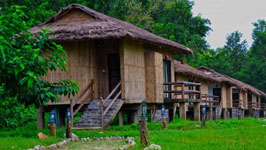NEPAL TOURS
Nepal
Sherpa Village

Pokhara’s bewitching beauty has been the subject of many travel writers. Its pristine air, spectacular backdrop of snowy peaks, serene lakes and surrounding greenery make it ‘the jewel in the Himalaya’, a place of remarkable natural beauty. With the magnificent Annapurna range forming the backdrop and the serenity of three major lakes Phewa, Rupa and Begnas Pokhara is the ultimate destination for relaxation. Pokhara Valley, gateway to the Annapurna region where many a trekker finds his Shangri-la, sits high on the list of ‘must visit’ places in Nepal.
According to Sherpa tradition, the tribe migrated to Nepal from the Kham region of eastern Tibet over a thousand years ago. Historians, however, suggest that the Sherpas were nomadic herders who were driven out of their original homeland in eastern Tibet by warlike peoples sometime between the twelfth and fifteenth centuries AD . They migrated to the area around Tingri, but conflict with the local inhabitants caused them to move on in search of new pastures. They crossed the Himalayas and settled peacefully in their present homeland in northeastern Nepal.
Pokhara once lay on the important trade route between India and Tibet. To this day, mule trains set up camps on the city outskirts, bringing goods from remote Himalayan regions including Mustang. Gurungs and Magars, who have earned world-wide fame as fierce Gurkha warriors, are predominant here. Thakalis, indigenous of the Thak Khola region of Mustang, are known for their entrepreneurship and run tea houses along the trek routes in the Annapurna region.
Location
The current Sherpa population is estimated to be around 45,000 people. They mainly live in the Khumbu and Solu Khumbu regions that lie to the south of Mount Everest. Sherpas also live to the east of this area in Kulung. In addition, Sherpas inhabit the valleys of the Dudh Kosi and Rolwaling Rivers west of Solu-Khumbu, and they are also found in the Lantang-Helambu region north of Kathmandu. Kathmandu itself has a sizable Sherpa population, while small numbers of Sherpas can be found throughout Nepal, even in the Terai. Sherpa communities are also present in the Indian state of Sikkim and the hill towns of Darjiling and Kalimpong. The Sherpas are small in stature, relatively fair in complexion, with the distinctive facial features associated with peoples of Tibetan origin.
Language
The language of the Sherpas, called Sherpa or Sherpali, is a dialect of Tibetan, although it has borrowed heavily from neighboring languages. It belongs to the Tibeto-Burman branch of the Sino-Tibetan language family. The Sherpas use the Tibetan script for writing. Sherpas use Nepali in their dealings with other peoples.
Folklore
A unique element in Sherpa folklore is the Yeti, better known in the West as the "Abominable Snowman." According to one tale, Yetis were far more numerous in the past and would attack and terrorize local villagers. The elders of the village decided on a plan to eliminate the Yetis. The next day, the villagers gathered in a high alpine pasture and everyone brought a large kettle of chāng (maize beer). They also brought weapons such as sticks and knives and swords. Pretending to get drunk, they began to "fight" each other. Towards evening, the villagers returned to their settlement, leaving behind the weapons and large amounts of beer. The Yetis had been hidden in the mountains watching the day's events. As soon as the villagers left, they came down to the pasture, drank the rest of the beer, and started fighting among themselves. Soon, most of the Yetis were dead. A few of the less intoxicated escaped and swore revenge. However, there were so few left that the survivors retreated to caves high in the mountains where no one would find them. Occasionally, they reappear to attack humans.
Religion
Many of the great Himalayan mountains are worshiped as gods. The Sherpas call Mount Everest Chomolungma and worship it as the "Mother of the World." Mount Makalu is worshiped as the deity Shankar (Shiva). Each clan recognizes mountain gods identified with certain peaks that are their protective deities.
The day-to-day religious affairs of the Sherpas are dealt with by lamas (Buddhist spiritual leaders) and other religious practitioners living in the villages. It is the village lam a, who can be married and is often a householder, who presides over ceremonies, and rituals. In addition, shamans (lhawa) and soothsayers (mindung) deal with the supernatural and the spirit world. They identify witches (pem), act as the mouthpiece of gods and spirits, and diagnose illnesses.
An important aspect of Sherpa religion is the monastery or gompa . There are some two dozen of these institutions scattered through the Solu-Khumbu region. They are communities of lamas or monks (some-times of nuns) who take vows of celibacy and lead a life in isolation searching for truth and religious enlightenment. They are respected by and supported by the community at large. Their contact with the outside world is limited to the annual festivals to which the public is invited, and the reading of sacred texts at funerals.
Major Holidays
The major festivals of the Sherpas are Losar, Dumje, and Mani Rimdu. Losar, which falls towards the end of February, marks the beginning of the New Year in the Tibetan calendar. It is celebrated with much feasting and drinking, dancing, and singing.
Dumje is a festival celebrated for the prosperity, good health, and general welfare of the Sherpa community. It falls in the month of July, when the agricultural work is complete, the trading expeditions to Tibet have returned, and the Sherpas are preparing to take their herds into the high pastures. Over a seven-day period, Sherpas visit their local monasteries and offer prayers to their gods. There is much eating and drinking, and members of the younger generation participate in singing and dancing.
The colorful Mani Rimdu celebrations are held four times a year, twice in Khumbu (at the Tami and Tengboche monasteries) and twice in Solu-Khumbu (at the Chiwong and Thaksindhu monasteries). Monks in colorful costumes and elaborate masks impersonate gods and demons and perform religious dances intended to scare the evil spirits.
Feasting and drinking accompany all Sherpa festivals and celebrations except for Nyungne. This is a penance for sins committed during the previous year. For three days, laypeople abstain from drinking and dancing and may even undergo a complete fast. They visit the gompa to recite sacred texts with the lamas, or repeat the mantra Om Mani Padme Hum . The principal mantra of the Buddhists, it is also found inscribed on prayer wheels. It has many interpretations, one of which is "Om, the Jewel of the Doctrine is in the Lotus of the World." Monks and nuns keep to the restrictions of Nyungne for two weeks.



